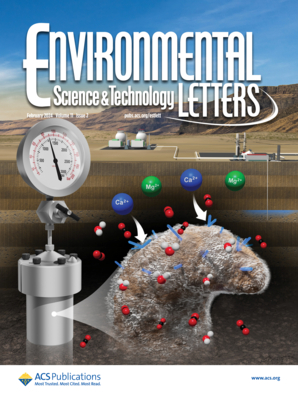机器学习可识别心肾代谢疾病和心血管死亡事件风险较高的人群,这些人群有降低未来心血管风险的机会但尚未实现
IF 8.9
2区 环境科学与生态学
Q1 ENGINEERING, ENVIRONMENTAL
Environmental Science & Technology Letters Environ.
Pub Date : 2024-10-28
DOI:10.1093/eurheartj/ehae666.2689
引用次数: 0
摘要
背景 机器学习可能能够利用常规收集的数据识别心肾代谢事件风险个体,这些个体可能适合有针对性的预防策略。 目的 训练和测试一种机器学习算法,以识别心肾代谢疾病事件和心血管死亡风险较高的个体,然后确定是否有机会降低他们未来的心血管风险。方法 我们在英国初级医疗电子病历数据中训练了一个随机分类器(OPTIMISE),这些数据来自年龄≥30 岁的 2 081 139 人(1998 年 1 月 2 日,2018 年 11 月 30 日),随机分为训练数据集(80%)和测试数据集(20%)。我们计算了十种心肾代谢疾病和死亡的累积发病率。Fine和Gray的死亡竞争风险模型适用于预测风险较高和较低的每种结果。在一项多中心试点干预性单臂研究中,年龄≥30 岁、预测风险较高的同意者接受了心肾代谢表型分析和指南目标达标评估。结果 在测试数据集(n = 416 228)中,预测风险较高的人患以下疾病的长期风险较高:心力衰竭(HR 12.54)、主动脉瓣狭窄(HR 9.98)、房颤(HR 8-75)、中风/TIA(HR 8.07)、慢性肾脏病(HR 6.85)、心血管病(HR 6.62)、瓣膜性心脏病(HR 6.49)、心肌梗死(HR 5.02)、糖尿病(HR 2.05)和慢性阻塞性肺病(HR 2.02)(图 1)。这组患者的死亡风险也较高(HR 10.45),在 10 年的随访期间,占心血管死亡人数的 74%(11 676 人中有 8 582 人死亡)。在试点研究的 82 名高风险患者中(平均年龄 71.6 岁(SD 7.5),50% 为女性),心肾代谢疾病的发病率较高(表 1),有机会降低未来的心血管风险。在高危高血压患者中,58.5%(31/53)的 80 岁患者收缩压为 140mmHg,54.5%(6/11)的≥80 岁患者收缩压为 150mmHg。在患有 2 型糖尿病并同时伴有 ASCVD 的患者中,只有 23.1%(3/13)正在接受 SGLT2 抑制剂治疗。在接受他汀类药物治疗的高危患者中,37.0%(20/54)的患者的低密度脂蛋白胆固醇为 1.8 mmol/L,52.0%(12/25)曾患有 ASCVD 的患者的低密度脂蛋白胆固醇为 1.4 mmol/L。此外,19.5%(16/82)的高风险人群患有未确诊的中度或高风险慢性肾脏病;他们很少服用他汀类药物(41.7%;5/12)、ACE-i/ARB疗法(61.5%. 8/13)或SGLT2抑制剂(83.3%(5/6))。49%的患者患有肥胖症,17%(14/82)的患者符合 GLP-1 RA 治疗条件。结论 机器学习 OPTIMISE 算法可以利用日常收集的数据识别心肾代谢疾病和死亡风险较高的人群。在前瞻性评估中,高风险人群患有未记录和治疗不足的心肾代谢疾病,而这些疾病是预防性护理的可行目标。本文章由计算机程序翻译,如有差异,请以英文原文为准。
Machine learning identifies individuals at higher risk of incident cardio-renal-metabolic diseases and cardiovascular death who have unrealised opportunities to reduce future cardiovascular risk
Background Machine learning may be able to identify individuals at risk of cardio-renal-metabolic events using routinely-collected data, and these individuals may be suitable for targeted preventative strategies.(1, 2) Purpose To train and test a machine learning algorithm to identify individuals at higher risk of incident cardio-renal-metabolic diseases and cardiovascular death, and then establish if there are opportunities to reduce their future cardiovascular risk. Methods We trained a random classifier (OPTIMISE) in UK primary care EHR data from 2 081 139 individuals aged ≥30 years (Jan 2, 1998, Nov 30, 2018), randomly divided into training (80%) and testing (20%) datasets. We calculated the cumulative incidence rate for ten cardio-renal-metabolic diseases and death. Fine and Gray’s models with competing risk of death were fit for each outcome between higher and lower predicted risk. In a multi-centre pilot interventional single arm study consenting individuals aged ≥30 years at higher predicted risk received cardio-renal-metabolic phenotyping and assessment for guideline target attainment. Results In the testing dataset (n = 416 228), individuals at higher predicted risk had higher long-term risk of heart failure (HR 12.54), aortic stenosis (HR 9.98), AF (HR 8·75), stroke/TIA (HR 8.07), CKD (HR 6.85), PVD (HR 6.62), valvular heart disease (HR 6.49), MI (HR 5.02), diabetes (HR 2.05) and COPD (HR 2.02) (Figure 1). This cohort were also at higher risk of death (HR 10.45), accounting for 74% of cardiovascular deaths (8 582 of 11 676) during 10-year follow up. Of 82 higher risk patients in the pilot study (mean age 71.6 years (SD 7.5), 50% women), the prevalence of cardio-renal-metabolic disease was high (Table 1), and there were opportunities to reduce future cardiovascular risk. Of higher risk patients with hypertension, 58.5% (31/53) of those aged <80 years had a systolic blood pressure (SBP)>140mmHg, and 54.5% (6/11) of those aged ≥80 years had a SBP >150mmHg. Of those with type 2 diabetes and co-existent ASCVD, only 23.1% (3/13) were on SGLT2 inhibitor therapy. Of higher risk patients on statin therapy, 37.0% (20/54) had LDL-cholesterol >1.8 mmol/L, and 52.0% (12/25) of patients with previous ASCVD had an LDL-cholesterol >1.4mmol/L. Furthermore, 19.5% (16/82) of the higher risk cohort had undiagnosed moderate or high risk CKD; who were infrequently prescribed a statin (41.7%; 5/12), ACE-i/ARB therapy with co-existent hypertension (61.5%. 8/13), or SGLT2 inhibitor with co-existent diabetes (83.3% (5/6)). Obesity was present in 49%, and 17% (14/82) were eligible for GLP-1 RA therapy. Conclusions The machine learning OPTIMISE algorithm can identify people at higher risk of cardio-renal-metabolic diseases and death using routinely collected data. On prospective evaluation higher risk individuals have unrecorded and undertreated cardio-renal-metabolic diseases, which are actionable targets for preventative care.Figure 1
求助全文
通过发布文献求助,成功后即可免费获取论文全文。
去求助
来源期刊

Environmental Science & Technology Letters Environ.
ENGINEERING, ENVIRONMENTALENVIRONMENTAL SC-ENVIRONMENTAL SCIENCES
CiteScore
17.90
自引率
3.70%
发文量
163
期刊介绍:
Environmental Science & Technology Letters serves as an international forum for brief communications on experimental or theoretical results of exceptional timeliness in all aspects of environmental science, both pure and applied. Published as soon as accepted, these communications are summarized in monthly issues. Additionally, the journal features short reviews on emerging topics in environmental science and technology.
 求助内容:
求助内容: 应助结果提醒方式:
应助结果提醒方式:


